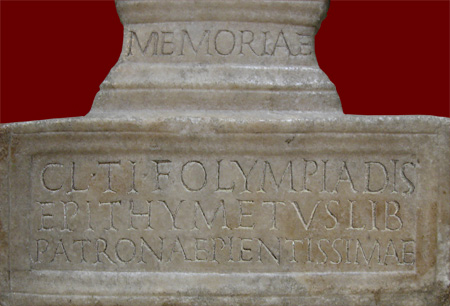 Marble bust of Claudia Olympias |
This memorial bust of Claudia Olympias portrays a matrona of some substance in her prime, attired in a revealing dress of clinging fabric and featuring a layered coiffure of curls and coiled braids that suggests a date in the late Trajanic to early Hadrianic period (first quarter of the 2nd century CE). Her name is a mixture of Roman and Greek names, a result perhaps of her citizen family's migration to Rome from the eastern Mediterranean or of her father's status as a freedman (see names). This memorial, carved by a talented sculptor, was no doubt costly; as such it speaks to her freedman's gratitude for her patronage (see patron-client relationship) as well as the post-manumission financial success of her former slave Epithymetus. A total of three inscriptions in Rome are published under the title Claudia Olympias, daughter of Tiberius, in the Corpus Latinarum Inscriptionum 6. The first two are complete and seem likely to refer to the same woman (see below). The third, badly damaged (CIL 6.15520), cannot refer to this woman because of the age differential; it may possibly be an epitaph for a younger sister. |
| CIL 6.15518: this inscription is carved on the base of the portrait bust above. |
 |
| MEMORIAE |
| CL[audiae] TI[berii] F[iliae] OLYMPIADIS |
| EPITHYMETVS LIB[ertus] |
| PATRONAE PIENTISSIMAE |
| CIL 6.15519: the epitaph below appears on a funerary monument dedicated by Olympias' husband Occius Publilius Eutychus, who bears a name that suggests he was a freedman. Because he specifies the length of Olympias' life at her death as well as the time they spent together as husband and wife, it is possible to calculate how young she was at marriage. |
| DIS MANIBUS |
| CLAUDIAE TI[iberii] FIL[iae] |
| OLYMPIADI |
| VIXIT A[nnos] XLVIIII M[enses] VI D[ies] X |
| OCCIUS PUBLILIUS |
| EUTYCHUS CONIUGI |
| SUAE CARISSIMAE |
| CUM QUA VIVIT |
| ANN[os] XXXIII |
Click on the underlined words for translation aids and commentary, which will appear in a small window. Close the small window after each use.